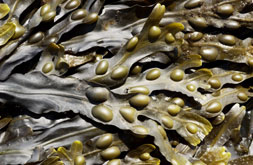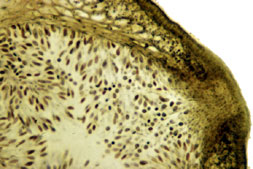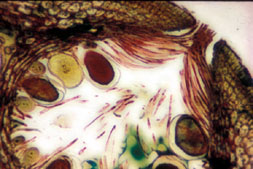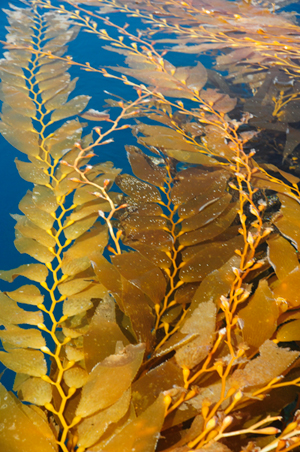CHARACTERISTIC
The brown colour of these algae results from the
dominance of the xanthophyll pigment fucoxanthin, which masks the other
pigments, Chlorophyll a and c (there is no Chlorophyll b), beta-carotene
and other xanthophylls. Food reserves are typically complex
polysaccharides, sugars and higher alcohols. The principal carbohydrate
reserve is laminaran, and true starch is absent (compare with the green
algae). The walls are made of cellulose and alginic acid, a long-chained
heteropolysaccharide.
There are no known unicellular or colonial representatives;
the simplest plant form is a branched, filamentous thallus. The kelps
are the largest (up to 70 m long) and perhaps the most complex brown
algae, and they are the only algae known to have internal tissue
differentiation into conducting tissue; there is, however, no true xylem
tissue as found in the 'higher' plants.

Most
brown algae have an alternation of haploid and diploid generations. The
haploid thalli form isogamous, anisogamous or oogamous gametes and the
diploid thalli form zoospores, generally by meiosis. The haploid
(gametangial) and diploid (sporangial) thalli may be similar
(isomorphic) or different (heteromorphic) in appearance, or the
gametangial generation may be extremely reduced (Fucales). The brown
Giant Kelp
Macrocystis pyrifera
(top) is harvested off the coasts of California for feeding abalone.
It used to be used for alginate extraction, but this now mostly comes
from Atlantic
Ascophyllum nodosum and
Laminaria hyperborea. Alginates,
derivatives of alginic acids, are used commercially for toothpastes,
soaps, ice cream, tinned meats, fabric printing, and a host of other
applications. It forms a stable viscous gel in water, and its primary
function in the above applications is as a binder, stabilizer,
emulsifier, or moulding agent.
Saccharina japonica, formerly
Laminaria, and other species of the genus are grown on ropes in China, Korea and Japan for food and alginate production.
Undaria pinnatifida is
also cultivated in Japan, Korea and China for production of Wakame, a
valuable food kelp. Small amounts are also grown in Atlantic France for
the European market.

About 16,000 tonnes of
Ascophyllum nodosum (above
, Feamainn bhuí
in Irish, referring to the yellow colour in summer) are harvested each
year in Ireland, dried and milled in factories at Arramara Teo., Cill
Chiaráin (Kilkerrin), Co. Galway; and some 3,000 t of the resulting
seaweed meal is exported and processed in Scotland for the production of
alginic acid.
Laminaria hyperborea
stipes (sea rods) are harvested in Norway and used to be collected in
drift in Scotland and Ireland. The rods are used for the manufacture of
high-grade alginates. Other brown algae are used for the extraction of
agricultural sprays ('liquid seaweed extracts').
These extracts are used at low concentrations on crops and their
hormone-like activities are thought to be due to betaines, cytokinenins,
etc. In some areas, like the west of Ireland and Scotland, kelps and
other brown algae are gathered as a fertiliser for land
There are about 1800 species
of brown algae, and most are marine. In general, brown algae are larger
and more species are found in colder waters. Virtually all the biomass
worldwide comes from a relatively small number of species in the orders
Laminariales and Fucales. The total wholesale value of dried brown algae
worldwide collected in the wild or cultivated is less than $100 million
dollars.

 Description: Spiralled Wrack, Fucus spiralis, is the uppermost species of Fucus that occurs on the shore. The frond lacks bladders (Fucus vesiculosus) and does not have a serrated edge (Fucus serratus); it is sometimes spiralled. This species has recently had another, common species segregated from it, Fucus guiryi. For characters to distinguish the two species, go to the description of this entity.
Description: Spiralled Wrack, Fucus spiralis, is the uppermost species of Fucus that occurs on the shore. The frond lacks bladders (Fucus vesiculosus) and does not have a serrated edge (Fucus serratus); it is sometimes spiralled. This species has recently had another, common species segregated from it, Fucus guiryi. For characters to distinguish the two species, go to the description of this entity.
 Description: Dichotmously branched fronds arising from
a small disc via a short stipe; distinct midrib. Plants to 300 mm with
terminal, compressed receptacles with warty conceptacles. This is the
"Serrated wrack" of the lower shore in the north-eastern Atlantic. It is
easily recognised by its saw-toothed frond, and a lack of swollen
receptacles (see below).
Description: Dichotmously branched fronds arising from
a small disc via a short stipe; distinct midrib. Plants to 300 mm with
terminal, compressed receptacles with warty conceptacles. This is the
"Serrated wrack" of the lower shore in the north-eastern Atlantic. It is
easily recognised by its saw-toothed frond, and a lack of swollen
receptacles (see below). 

 found in some species and these help to keep the plant afloat when submerged.
found in some species and these help to keep the plant afloat when submerged. The
male reproductive structures (left, in section) are called
antheridiophores which are branched, tree-like structures that line the
conceptacles. The antheridiophores have terminal inflated antheridia on
their branches; these undergo meiosis and form 64-128 biflagellate male
gametes (antherozoids).
The
male reproductive structures (left, in section) are called
antheridiophores which are branched, tree-like structures that line the
conceptacles. The antheridiophores have terminal inflated antheridia on
their branches; these undergo meiosis and form 64-128 biflagellate male
gametes (antherozoids). causes
dessication and the gametes are squeezed onto the surface of the
receptacle, and are then washed off and mixed by the inoming tide. The
female egg liberates a volatile hydrocarbon, fucoserraten (a compound
with 8 carbon atoms) which attracts the male antherozoids; these cluster
around the egg and spin it; one penetrates the complex series of coats
around the egg and karyogamy (nuclear fusion) occurs. The zygotic cell
settles down and germinates to form a new diploid thallus. Strictly
speaking, the so-called gametophyte thallus in Fucus is a
sporophyte that undergoes meiosis just before gametes are formed. This
is the reason why some textbooks refer to the male gametangia as
'microsporangia' and the female gametangia as 'megasporangia'. Fucus
species are found in the upper, mid, and lower intertidal in the colder
waters of the northern Atlantic and northern Pacific. The genus is
absent from the southern hemisphere.
causes
dessication and the gametes are squeezed onto the surface of the
receptacle, and are then washed off and mixed by the inoming tide. The
female egg liberates a volatile hydrocarbon, fucoserraten (a compound
with 8 carbon atoms) which attracts the male antherozoids; these cluster
around the egg and spin it; one penetrates the complex series of coats
around the egg and karyogamy (nuclear fusion) occurs. The zygotic cell
settles down and germinates to form a new diploid thallus. Strictly
speaking, the so-called gametophyte thallus in Fucus is a
sporophyte that undergoes meiosis just before gametes are formed. This
is the reason why some textbooks refer to the male gametangia as
'microsporangia' and the female gametangia as 'megasporangia'. Fucus
species are found in the upper, mid, and lower intertidal in the colder
waters of the northern Atlantic and northern Pacific. The genus is
absent from the southern hemisphere.

 Most
brown algae have an alternation of haploid and diploid generations. The
haploid thalli form isogamous, anisogamous or oogamous gametes and the
diploid thalli form zoospores, generally by meiosis. The haploid
(gametangial) and diploid (sporangial) thalli may be similar
(isomorphic) or different (heteromorphic) in appearance, or the
gametangial generation may be extremely reduced (Fucales). The brown
Giant Kelp Macrocystis pyrifera
(top) is harvested off the coasts of California for feeding abalone.
It used to be used for alginate extraction, but this now mostly comes
from Atlantic Ascophyllum nodosum and Laminaria hyperborea. Alginates,
derivatives of alginic acids, are used commercially for toothpastes,
soaps, ice cream, tinned meats, fabric printing, and a host of other
applications. It forms a stable viscous gel in water, and its primary
function in the above applications is as a binder, stabilizer,
emulsifier, or moulding agent. Saccharina japonica, formerly Laminaria, and other species of the genus are grown on ropes in China, Korea and Japan for food and alginate production. Undaria pinnatifida is
also cultivated in Japan, Korea and China for production of Wakame, a
valuable food kelp. Small amounts are also grown in Atlantic France for
the European market.
Most
brown algae have an alternation of haploid and diploid generations. The
haploid thalli form isogamous, anisogamous or oogamous gametes and the
diploid thalli form zoospores, generally by meiosis. The haploid
(gametangial) and diploid (sporangial) thalli may be similar
(isomorphic) or different (heteromorphic) in appearance, or the
gametangial generation may be extremely reduced (Fucales). The brown
Giant Kelp Macrocystis pyrifera
(top) is harvested off the coasts of California for feeding abalone.
It used to be used for alginate extraction, but this now mostly comes
from Atlantic Ascophyllum nodosum and Laminaria hyperborea. Alginates,
derivatives of alginic acids, are used commercially for toothpastes,
soaps, ice cream, tinned meats, fabric printing, and a host of other
applications. It forms a stable viscous gel in water, and its primary
function in the above applications is as a binder, stabilizer,
emulsifier, or moulding agent. Saccharina japonica, formerly Laminaria, and other species of the genus are grown on ropes in China, Korea and Japan for food and alginate production. Undaria pinnatifida is
also cultivated in Japan, Korea and China for production of Wakame, a
valuable food kelp. Small amounts are also grown in Atlantic France for
the European market.